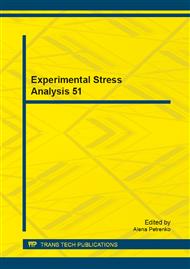p.129
p.135
p.141
p.147
p.151
p.157
p.163
p.167
p.173
Determine Parameters for Double-K Model at Three-Point Bending by Application of Acoustic Emission Method
Abstract:
As concrete is one of the most popular building materials, it is important to know its basic properties and behaviour especially at loading. When cracks occur in concrete, released fracture energy will be proportionally transformed into the energy contained in acoustic emission. According to this physical phenomenon, acoustic emission technique provides an effective monitoring method for fracture process of concrete through generated acoustic emission. However, such monitoring is limited in qualitative evaluation of fracture process in most occasions. Quantitative interpretation of fracture process is difficult to accomplish by simply acquiring the amount of acoustic emission generated or by conducting parameter-based acoustic emission analysis. This paper investigates the use of the double-K fracture model and acoustic emission for prediction of load at the beginning of stable crack propagation in three-point bending tests of concrete specimens. Double-K model combines the concept of cohesive forces acting on the effective crack increment with a criterion based on the stress intensity factor.
Info:
Periodical:
Pages:
151-156
Citation:
Online since:
December 2013
Price:
Сopyright:
© 2014 Trans Tech Publications Ltd. All Rights Reserved
Share:
Citation:


